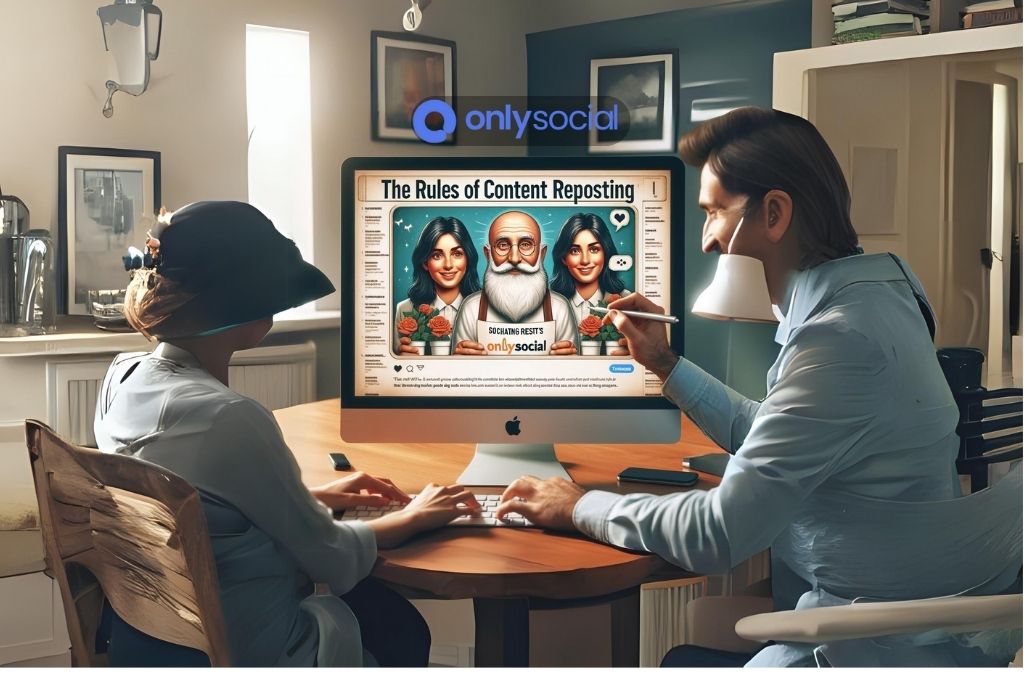Mastering Content Reposting Etiquette: A Comprehensive Guide

In today’s digitally-driven world, sharing information has become as natural as breathing. Content virality and the urge to share the latest updates or fascinating articles can sometimes override our judgment. As a result, the crucial aspect of respecting creators may fall by the wayside. This is where understanding and adhering to content reposting etiquette becomes paramount.
In this post, we’ll delve into the ins and outs of content reposting etiquette, shedding light on its importance, and providing the necessary guidelines to ensure an ethical approach to sharing content across various platforms. As you navigate this comprehensive guide, you’ll discover the most effective ways to maintain your online reputation and accord respect to the original creators.
Stay with us as we explore the significance of content reposting etiquette and educate you on how to set a good example in the digital sphere. So, buckle up and get ready for an illuminating journey to becoming a mindful advocate of online content sharing.
Table of Contents [show]
Understanding Content Reposting
The internet is abuzz with a myriad of content forms: blog posts, articles, videos, infographics, images, and more. As a result, reposting has become a common phenomenon. But what exactly does content reposting mean? And how does it tie in with content reposting etiquette?
What is Content Reposting?
Content reposting, simply put, involves sharing an original piece of work on one’s own or another platform. This could involve sharing a captivating blog post on your website, podcasting platforms, or reposting someone’s photo on Instagram. Yes, reposting helps disseminate information far and wide, bringing valuable content to a wider audience. However, it’s crucial always to bear in mind that the content you’re sharing belongs to someone else. Hence, it’s paramount to treat it with respect, which leads us to content reposting etiquette.
Why does Content Reposting Etiquette matter?
| Content Reposting Concerns | Importance of Reposting Etiquette |
|---|---|
| Plagiarism | Avoiding plagiarism is one of the most crucial aspects of respecting content reposting etiquette. In its simplest form, plagiarism involves taking someone else’s work and passing it off as your own. Fees and legal actions could be taken against plagiarists. |
| Negative SEO Impact | Duplicate content can have a negative impact on SEO, which may affect your website’s ranking. Appropriate reposting, with due credit and necessary permissions, can help you avoid these issues. |
| Damaging Relationships | Disrespecting the hard work of content creators or not acknowledging them while reposting their content can lead to damaged relationships and harm your brand’s reputation. |
Content reposting etiquette can act as a shield against these issues. Remember: knowledge is power. By understanding how to respectfully repost content, you can enjoy the benefits of sharing while maintaining positive relationships with the original creators. More importantly, you’ll earn respect in the eyes of your audience who will appreciate your ethical approach to reposting. So, let’s set off on our journey to discover the rules of content reposting etiquette.
The Rules of Content Reposting
Unlocking the secrets to ethical and respectful reposting is essential for carrying out seamless content-sharing practices. By following these rules, you’ll be able to avoid potential pitfalls and maintain a positive online reputation. Let’s delve into the core tenets of content reposting etiquette.
1. Seek Permission
The golden rule of content reposting etiquette is seeking permission before sharing other people’s work. Even though the internet may seem like an open reservoir of information, it’s vital to honor intellectual property rights. Reach out to the content creator, whether by email or through social media platforms and ask for their consent.
Keep in mind that creators hold different perspectives on others sharing their work, and some may not want their content redistributed. So, when you respect their wishes, you’ll be fostering positive relationships and projecting an ethical image.
2. Give Credit
Once you’ve obtained permission to repost or share, always give credit to the original author. Acknowledge their work by including their name, link to the original content source, and, if applicable, their social media handles. Not only does this reflect a high level of professionalism, but it also ensures that your audience knows the true author and where to find more of their work.
3. Use Reposting Tools and Practices
Many platforms have built-in reposting tools, designed to simplify the process and provide appropriate attribution automatically. Here are some examples:
| Platform | Reposting Tools & Practices |
|---|---|
| Retweeting is the simplest way to share content on Twitter, which retains the original tweet (with the author’s handle) and distributes it to your followers. | |
| You can click “Share” on a public post, and it will be reposted on your timeline, with a link back to the original post or author. | |
| For Instagram sharing, consider using tools like Repost for Instagram and Regram App, which maintain the original creator’s username and provide proper attribution in the caption. |
By leveraging these native tools or designated apps, you simplify adherence to content reposting etiquette and minimize the risk of plagiarizing content.
Armed with these fundamental rules of content reposting, you’re well on your way to becoming an ethical advocate of sharing content online. But, to complete your arsenal, let’s dive into some essential dos and don’ts of the content reposting realm.
The Do’s and Don’ts of Content Reposting
While understanding the basic rules of content reposting etiquette is the first step, navigating the more intricate aspects of content reposting requires a little more finesse. Here, we break down some of the crucial do’s and don’ts to help you maintain impeccable content reposting etiquette.
The Do’s
Do Personalize Your Post
While the original work should remain intact, personalizing your repost with a comment or introduction can enhance engagement with your audience. This demonstrates your genuine interest in the content you’re sharing, rather than simply reposting for the sake of it.
Do Limit Your Reposting
Even with the best content reposting etiquette, overdoing reposting can still have negative effects. If your feed or blog becomes primarily reposted content, your original voice can get lost. Maintain a balance by ensuring your original work outnumbers reposted content.
The Don’ts
Don’t Edit Original Content
Unless expressly allowed by the original creator, keep their content as is, without making any alterations. This includes changing the title, graphics or the core content. Respecting the original work underpins true content reposting etiquette.
Don’t Fail to Check Facts
Before reposting any piece of content, it’s crucial to ensure that the information presented is accurate and factual. Sharing incorrect or exaggerated information can damage your credibility and harm your audience’s trust.
Don’t Neglect Content Quality
Reposting should not compromise the quality standards of your platform or brand. Be selective in choosing content to repost, prioritizing articles or posts that add value to your audience.
| The Do’s | The Don’ts |
|---|---|
| Do personalize your post | Don’t edit original content |
| Do limit your reposting | Don’t fail to check the facts |
| Don’t neglect content quality |
By following these do’s and don’ts, you can elevate your understanding and practice of content reposting etiquette, thereby fortifying your role as a responsible member of the online content community.
Real-world Examples of Good and Bad Content Reposting
Being abstract sometimes, the principles of content reposting etiquette will become clearer when we bring them to life with some real-world examples. It’s important to note that these are hypothetical scenarios that typically occur on various platforms, intended to help you better understand the concept.
Good Content Reposting Examples
- Example 1: A fitness blogger comes across a motivating article on a healthy diet on another blog. Moved by the quality and message of the content, they decided to share it on their platform. The blogger reaches out to the original content creator, asking for permission to repost, and upon receiving it, republishes the article on their site. They make sure to include the author’s name, a link back to the original source, and an introduction appreciating the original creator’s work.
- Example 2: An Instagram user finds a stunning travel photograph on a photographer’s profile. Instead of saving the photo and posting it as their own, they utilize a reposting app to share the photograph. This inclusion of the creator’s Instagram handle in the caption and comments on the beauty of the photograph ensures the audience knows who the original creator is.
Bad Content Reposting Examples
- Example 1: A business website, looking for fresh content, finds an insightful industry article on another site. Without contacting the author or the original website, they simply copy the content, slightly tweak it, and post it on their site as a new blog post. The original author or site is not credited. This not only breaches content reposting etiquette but also paves the way for severe plagiarism accusations.
- Example 2: A Twitter user spots an interesting post from another user. They choose to screenshot the tweet instead of retweeting it and then post the screenshot as a new tweet. This method strips away any connection to the original author, making it appear as if it’s their content.
By understanding these examples, you can refine your content reposting etiquette and become a champion of ethical reposting practices, distinguishing between what should be done and what should be avoided.
BONUS
Elevate your content reposting game with OnlySocial’s powerful post-planning and Scheduling function. Seamlessly plan and schedule posts across all your social networks with unlimited posting and the ability to manage unlimited social profiles. Why leave your social presence to chance when you can take control? Sign up for a commitment-free 7-day trial today.
Frequently Asked Questions
What is content reposting?
Content reposting involves sharing an original piece of work on one’s own or another platform. This could mean sharing a captivating blog post on your website or reposting someone’s photo on Instagram.
What is content reposting etiquette?
Content reposting etiquette is a set of guidelines that ensure respectful and ethical reposting of content. These guidelines include seeking permission before reposting, giving credit to the original author, using proper reposting tools and practices, and more.
Why is content reposting etiquette important?
Content reposting etiquette is important to steer clear of plagiarism, avoid negative SEO impacts, and prevent damaging relationships with content creators. It helps in maintaining an ethical and professional online presence.
How to give credit while reposting content?
When reposting content, you should always cite the original author or creator. This could include mentioning their name, providing a link to the original content, or tagging their social media handles.
Is reposting content considered plagiarism?
Reposting content without permission and without giving credit to the original creator can be considered plagiarism. This can lead to legal repercussions and damage your online reputation.
Can reposting affect my SEO negatively?
Yes, Google and other search engines discourage duplicate content, and your site’s SEO ranking may suffer if you repost content without proper attribution and permission from the original creator.
Are there tools to help with content reposting?
Yes, many platforms have built-in reposting tools, and there are third-party applications as well that make reposting and attribution easier. Examples include ‘Repost for Instagram’ and ‘Regram App’ for Instagram, and the native ‘Retweet’ and ‘Share’ functions on Twitter and Facebook respectively.


